We explore the history of the University’s beloved clock tower and share alumni contributions about its name.
No matter when you graduated from Birmingham, chances are your memories of your time on campus include the iconic clock tower.
However, alumni across the decades won't have always agreed on what they called it.
With the help of Helen Fisher, Archivist from the Cadbury Research Library at the University, we've outlined the history of Old Joe and your thoughts on its name over the years.
-
1901
When plans were drawn up for the new University buildings at Edgbaston, architects Sir Aston Webb and Edward Ingress Bell always included a central tower but various designs were considered.
-
1905
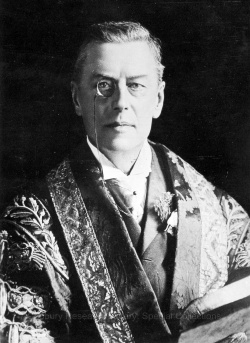
UC10/i/4/2, Cadbury Research Library, University of Birmingham
There weren’t enough funds to build the tower until 1905 when Joseph Chamberlain, the University’s first Chancellor and the person responsible for securing most of the donations to establish it, made suggestions about the design.
-
1906
The design was approved.
-
1907
Most of this year was spent on building foundations.
Christine M Johnson My maternal grandfather Richard Ebborn lived in Bourneville and was a builder by trade. He was involved with the building of Old Joe and our mother, Margaret Johnson, remembered taking sandwiches to him when he was working on the construction.
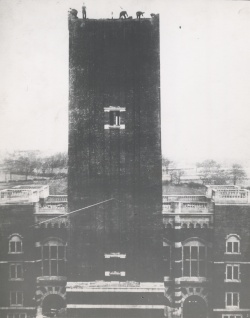
UA2/B, Cadbury Research Library, University of Birmingham (1908)
-
1908
Work on the tower continued. It was built from the inside without scaffolding. This was most likely when the decision was made to name it after Joseph Chamberlain, who suffered a stroke in 1906 and wasn’t able to be as closely involved. It was named the 'Chamberlain Memorial Tower' but became known as 'Joe.'
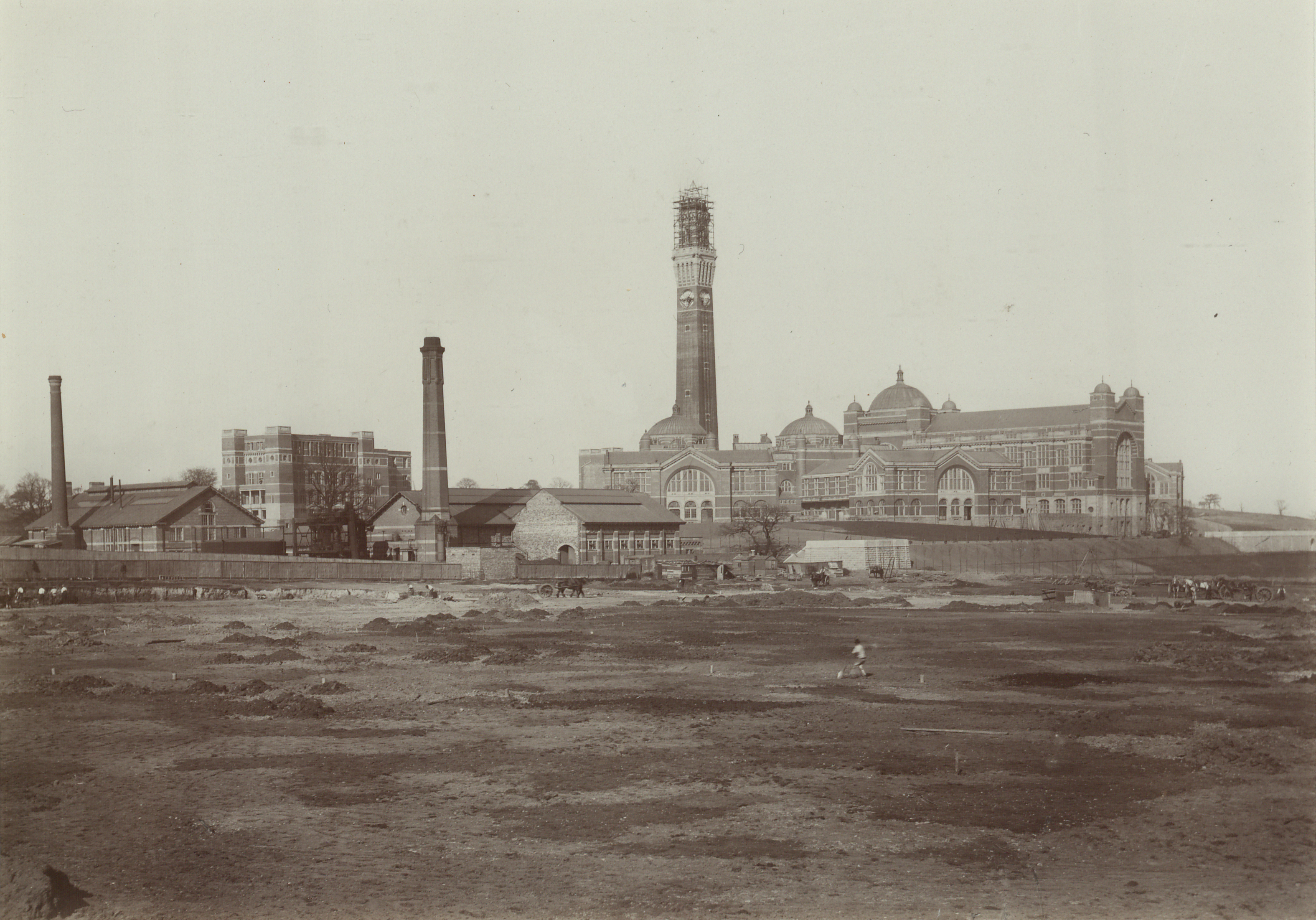
UA10/i/4, Cadbury Research Library, University of Birmingham
-
1914
Further work had to be carried out after it was discovered that the external brickwork had not been pointed, and rain was getting in. No scaffolding was needed, as workmen were suspended in hanging cages.
-
1944
Margaret Annie Sainsbury nee Jones (LDS Dentistry, 1944)
My mother, Margaret, did fire watching duties from the top of the clock tower during the Second World War. She always called it Old Joe. I graduated from Birmingham Medical School with my husband, Ian in 1973 and one of my sons, Timothy I.S Wilson (MBChB Medicine, 2004) is an alumnus.
From Jane Wilson (nee Sainsbury) (MBChB Medicine, 1973)
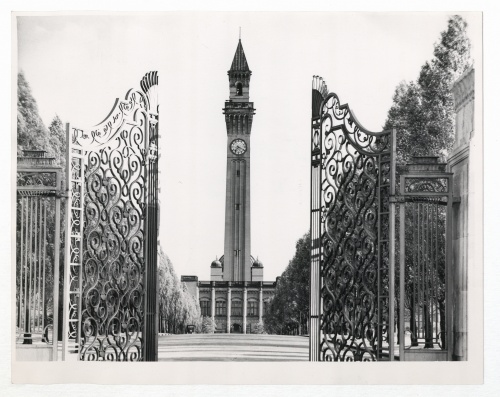
UA10/26 Cadbury Research Library, University of Birmingham
-
1951
Margaret Gilfillan (BCom Industrial Economics and Business Studies, 1951)
When I graduated Joe was definitely not Old Joe then.
-
1957
The first major repointing of the tower took place and surviving photographs in the University archives show the tower covered in scaffolding in around May 1957, but with no platforms or lifts.
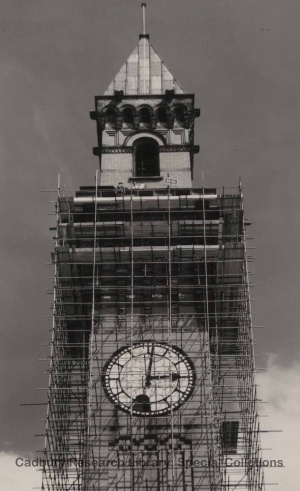
UB/PH/A/1/2/214, Cadbury Research Library, University of Birmingham
-
1957
T Martin Johnson (BSc Electronic and Electrical Engineering, 1957)
I was up from 1954 to 1957, and it was definitely Joe at that time.
-
1959
Valerie Stumbles (nee Rees) (BA Music and Geography, 1959)
In my day, Old Joe was still called Joe ...it hadn't reached the status of "old" by then.
-
1960
Brian Waterman (BCom Industrial Economics and Business Studies, 1960)
It was called Old Joe during my time at university.
-
1963
There were further repairs when the clock was overwound, which caused a cable to snap and the weight which struck the hour fell down the tower. The clock was out of action for a week.
-
1964
June Webber (BA French Language and Literature, 1964)
We always called the clock tower Joe, not Old Joe. In the early sixties there was a satirical publication simply called Wall that used to appear on one of the noticeboards in the student union. Late in the summer term of (I think) 1962 there was a trick photo showing Joe apparently relocated to the Lickey Hills. Accompanying text explained that he had been moved there for safety for the duration of the long vacation. The text added that the clock tower still on the Edgbaston campus was in fact a cardboard replica.
-
1964
J R E Stagg (BDS Dentistry, 1964)
When I graduated the clock tower was just know as Joe. There was nothing “old” about it then!
-
1964
Sue Branch (nee Heathcote) (BSc Geography, 1963; PGCE 1964)
It was called Old Joe when I arrived in 1960.
-
1964
Carole (Atkinson) Lewis (BA German and English, 1964)
I'm pretty sure we called him Old Joe in 1964.
-
1965
Stephen Hodson (BSc Electrical and Electronic Engineering, 1965)
In the early 1960s, it was always just Joe, so the change must have been after that period. I still think of 'him' as Joe; the new version just grates, I’m afraid.
-
1965
Marion Virgo (BA English, 1964; PGCE, 1965)
I never heard Joe called Old and I was also around the campus socially until 1967.
-
1967
Barry Nickels (BA German, 1967; PGCE, 1968)
I can confirm that when I left the University in the summer of 1968, having completed my PGCE, it was still called Joe, which appears to back up your feedback that the name change happened in the late sixties. There was a lot of upheaval in the next couple of years, so I guess the change might have happened in the early seventies.
-
1968
Michael Gilly (BSc Microbiology, 1968)
Old Joe was already "Old Joe" in my fresher year.
-
1968
Brian Greenlay (BSc Chemistry, 1968)
I graduated from the University in July 1968 and at that point the clock tower was always referred to as Joe.
-
1968
Alison Morris (BA Hons Ancient History and Archaeology, 1968)
It was always Joe. I'd never heard of "Old Joe" till the name started appearing in your magazine.
-
1968
Wendy Ford (BA Theology, 1967; PGCE Education, 1968)
Was definitely still just Joe to us in the 60s. I finally left in 1968. But it's/he's nearly 50 years older now!
-
1968
Martin Waldron (BSc Electronic and Electrical Engineering, 1968)
In the period when I was at Brum and certainly up until 1970 when my wife graduated, the tower was simply known as Joe. A friend of ours who came up in 1974, knew it as 'Old Joe,' so somewhere between 1970 and 1974, the new name seems to have crept in. It is possible that the 'Old Joe' name was evolving during our last years, say 1968-70, but neither of us knew it by that name. 'Old Joe' seems wrong to us. I don’t know if things have changed, but it was considered very unlucky to walk UNDER Joe when going to the Great Hall for final exams.
-
1969
Jill Mathew (BA French & Hispanic Studies, 1969)
The unofficial name was already well-established as Old Joe by the time I arrived. Not once did I ever hear it referred to just as "Joe."
-
1969
Alan Fell (BSc Civil Engineering, 1969)
I only ever heard the tower called Joe. Never did I hear the term 'Old Joe' and we civil engineers know all about such erections!
-
1969
Dave Wiggins (BSc Chemistry, 1969)
I never heard anyone call the clock tower anything but Joe. I don’t know when this change happened but from my experience it was definitely not the late 1960s.
-
1972
Sue Edmonds (BSc Biological Sciences, 1972)
I graduated in 1972 and always think of the tower as Joe.
-
1973
Philippa Bonorino (BA German and Physical Education, 1973)
Old Joe was what we called the clock tower.
-
1975
Carol Peacock (nee Jenner) (BA French, 1975)
To my knowledge, the clock tower was just called Joe when I graduated in 1975 - so the name changed after that.
-
1980
Helen Fisher, Cadbury Research Library
Helen Fisher, says 'evidence in the University Archives suggests that the clock tower was known as “Joe”, certainly until the late 1980s. The bar in the Guild of Students was re-named “Old Joe’s” in 1993 so it might have been around that time that other parts of the University began to call the tower Old Joe rather than Joe.'
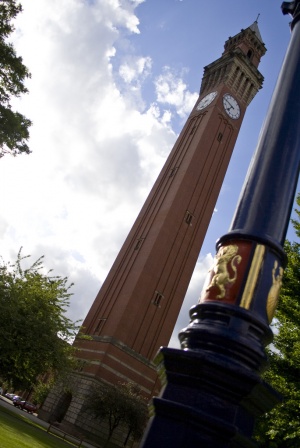
-
2019
The Green Heart
A striking new parkland in the centre of the University's historic campus will be completed in 2019.
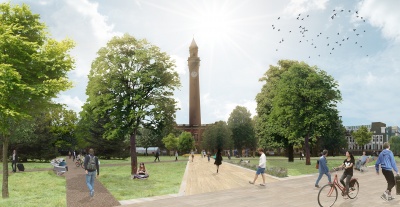
Did you know?
- Old Joe is the tallest free standing clock tower in the world
- It is based on the Torre del Mangia in Siena; It has been suggested that this was inspired by a visit Joseph Chamberlain made to Siena in November 1904, but he apparently studied photographs of similar structures elsewhere in Italy before making his decision
- The clock tower frequently changes colour to celebrate different awareness days. Last September it glowed gold for Childhood Cancer Awareness Month
- The Physics Department attached a radio aerial between the clock tower and the Harding Library in 1914. Sir Mark Oliphant, Professor of Physics between 1937 and 1950, used the tower for the research he led on the development of radar in 1940, which was used later in the Second World War in intercepting and directing aircraft
- Old Joe even has his own Twitter feed! Check him out @oldjoeclock
Tall tales
- Students and staff volunteering for duty during the Second World War as part of the University Home Guard might find themselves undertaking observation duty from the top of the clock tower – watching for enemy activity, and reporting fires or explosions from air raids. Obviously the views could be very good, and people on duty during raids on Birmingham and during the bombing of Coventry in November 1940 could see the fires there. Apparently it was possible to see planes passing quite close by, and it could be very cold at night at that height
- R. A. Gibson, an alumnus who was a student at Birmingham during the Second World War, was told that the Head Porter had a pair of binoculars so that he could climb the clock tower and read the scoreboard at Edgbaston Cricket Ground and pass messages to the Vice-Chancellor at the time, Sir Raymond Priestley, and the Registrar, George Grant, who were both cricket enthusiasts
- Eric Tompkins (BSc Applied/Pure Science, 1925) remembered that Dr Gilbert Shakespeare (a lecturer in Physics) had carried out research in the lift shaft of the clock tower on the terminal velocity of spheres falling in air. Ball bearings and table tennis balls were released at the top and hit a moveable trampoline which was set up on various floors in the tower. The release and arrival devices sent signals that were recorded against a tuning fork trace on the timing apparatus
Competition time!
In what year did the first major repointing of the tower take place?
Enter here for your chance to win a print of Old Joe. Competition closes: 31 May 2017